|
|
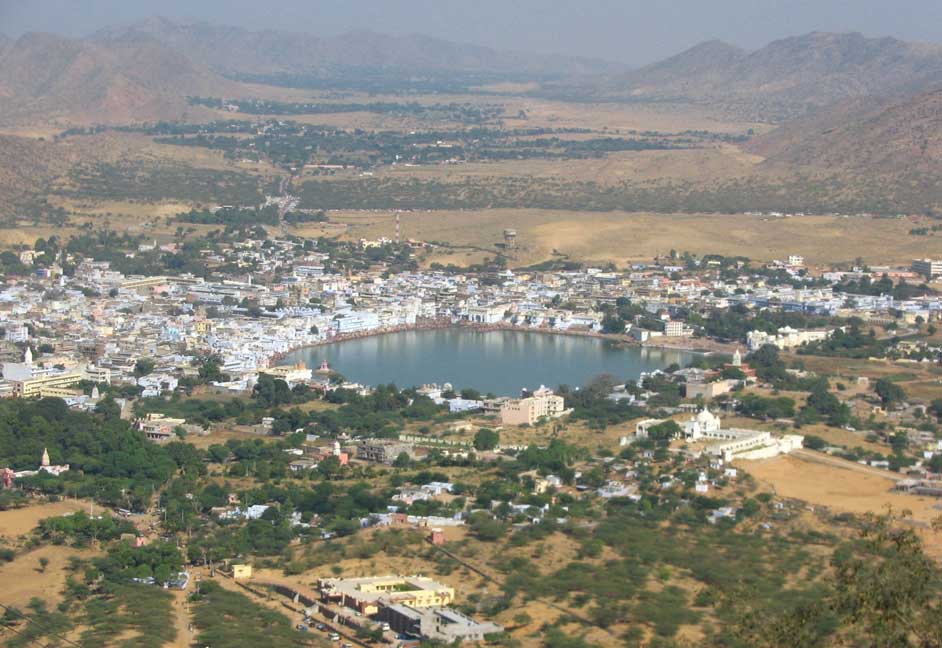 |
|
Pushkar Fair, Pushkar |
|
Introduction
of
Pushkar
Fair |
|
The rich culture and tradition
of Rajasthan comes alive at Pushkar. A small little town, just around
18 kms from the religious city of Ajmer, Pushkar, is host to an annual
event called the Pushkar fair. The fair visited by foreigners and
Indian alike is perhaps the largest assembly for a fair from tourists
all around the world in Rajasthan. Held in the Hindu month of Kartik
or November, attracts a large number of Tourists from all over the
World.
The Pushkar fair is a often a very unique experience for the tourists
as compared to any other fair. The beginning of winters bring the cool
winds from the south west, the golden sand hills spark various colours
with every phase of the Sun; adding to the natural colours are not
only the brightly dressed men and women or the shops selling various
colourful goods, but also the ornamented and decorated Camel and
cattle which are at sale here. The charm of the fair and also the
reason behind it becoming the world well-known fair is its original
and very rural charm. Here the people spontaneously break into a song
or a dance; they forget their daily problems and take pleasure of the
camel and the cattle races. They buy goodies and make merry. All this
adds to the attraction of the place and that too with a religious
touch to it.
|
|
When Pushkar Fair is Held |
|
The Pushkar Fair occurs every year in the Hindu month of
Kartik
(October /November), ten days after Diwali-The festival of Lights,
During this period Pushkar and its environs come alive as the much
awaited annual cattle fair starts at Pushkar. Hotels are full to their
capacity, tents and campsites suddenly spring up to accommodate the
thousands of pilgrims, tourists and villagers with large groups of
cattle, horses and camels who come here to participate in this grand
annual event.
|
|
Significance of Pushkar Fair |
|
Pushkar fair has always been the region's central cattle market for
local herdsmen and farmers who buy and sell camels, horses and breeds
of cattle. Pushkar fair is now one of Asia’s largest cattle fairs the
other major cattle fairs being Sonepur Mela in Bihar and Nagaur fair
also in Rajasthan. During Pushkar Mela, as the Pushkar fair is called
by locals, Pushkar is changed from a quiet little town into a sea of
kindness and beast, busy with activity and a scene of colour, sights
and smells very different to India.
The village folk visit the fair dressed in all their best clothes
.Tall Men in bright coloured turbans, with their weather beaten and
tanned faces supporting large well kept moustaches, ears cut
with gold and silver rings and tops , women wearing colourful Ghagra -
Cholis and bright Coloured Odhnis on their heads. Ears, necks, arms
,and feet full with silver and gold jewellry.
The photography opportunity that was provided at the Pushkar fair
is wonderful. Even the animals are ornamented by their owners.
Numerous camel, donkey and horse races and contests take place in the
middle of loud cheers from the audience during the Pushkar fair,.
These contests and competitions are conducted In the vast,
specially-built amphitheatre on the outer edge of the town, A festive,
carnival atmosphere dominates in Pushkar during the fair's two-week
duration.Very large transportation boat wheels and open air theatres
offer enjoyment, while food stalls do a efficient trade, as do the
shops that sell a attractive variety of goods.
In the evening, people assemble around campfires listening to
Rajasthani folk songs. The fair reaches a climax on the night of the
full moon (Kartik Purnima), when pilgrims take a bathe in the holy
lake. At early evening, during the beautiful Deepdaan ceremony,
hundreds of clay lamps on leaf boats are shining and set afloat on the
holy Pushkar lake.
|
|
Rituals and Traditions of Pushkar Fair |
|
These five days are a period of relaxation and amusement for the
villagers, regardless of being the busiest for them, as this is one of
the largest cattle fairs in the country. Animals, mostly camels, are
brought from miles around. Trading is efficient as several thousand
heads of cattle exchange hands. All the camels are cleaned, washed,
decorated, some are interestingly shorn to form patterns, and special
stalls are set up selling best clothes and jewelry for the camels.
Camels at the Pushkar fair are decorated with great care. They wear
jewelry of silver and beads. There are silver bells and bangles around
their ankles that jingle-jangle when they walk.
Pushkar has the only temple in India devoted to Lord Brahma, designer
of the three worlds. According to a tradition, as Lord Brahma was
searching for a suitable place to perform a yagnya, the lotus fell of
his hands and the place where it fell sprung out water. Since then the
lake of Pushkar was formed. The lake still stands with 52 bathing Ghat
on its banks. People gather around these ghat to take a bathe in the
holy lake and wash away all their crimes, it is a very popular belief
here. The lake was formed on the full moon day in the month of Kartik
that. This religious reason has given the world an opportunity to be a
part of one of the most fabulous fairs of the world.
|
|
Special Attractions of Pushkar Fair |
|
The charming lake of Pushkar is situate in a valley just about 11
kilometres northwest of Ajmer, enclosed by hills on three sides and
sand dunes on the fourth. Pushkar forms an attractive location and a
suitable backdrop for the annual religious and cattle fair. Turbaned
heads of men, and colorful veils and skirts of the women, bring alive
the dry deserts cape. The village women dress in their best colourful
clothes and best clothes for the five-day mela.
In the afternoons, people gather together at the stadium where camels,
horses, and cows are paraded and raced. Camels are bought and sold
during the Pushkar fair.
Like Varanasi, Pushkar is one of the sacred places for the Hindus,
with 400 temples of which the most significant is devoted to Lord
Brahma - the maker of the universe. Fifty-two Ghats attach the lake.
On the roadside, stalls of all kinds are set up to sell a large amount
of items. Almost every household is busy in setting them up as the
locals try to take advantage of the massive arrival of people. It is
impossible to drive around because of the large crowds. Either you
hire a camel or you walk. In this aspect, it is truly a rural bazaar.
An interesting part of the Pushkar Fair is the mass trading of camels.
Of course, cattle and other livestock are also traded, but it's camels
that hold center stage at Pushkar. Camel-traders and villagers from
miles away meet come to Pushkar. Over 25,000 camels (on the
conservative side) are traded; making this world's largest camel fair.
Alcohol and non-vegetarian food is prohibited in Pushkar since Pushkar
is a religious place.
|
|
Location |
|
The sacred city of Pushkar is situated in the Ajmer district of
Rajasthan, India. Pushkar is one of the five holy dhams or pilgrimage
sites for religious Hindus. One of the oldest cities of India. Pushkar
lies on the coast of the sacred Pushkar Lake. The holy waters of the
Pushkar Lake are well thought-out at par with the waters of the
Mansarovar lake positioned on way to Mount Kailash the residence of
Shiva. The date of actual origin of Pushkar is unknown, but legend
associates Lord Brahma with its creation.
|
|
Attractions of Pushkar |
|
Besides the Pushkar fair, Pushkar also has a lot of temples and 52
Ghats; the most well-known temple in Pushkar is the Brahma Temple,
devoted to Lord Brahma, The originator of the Universe according to
Hindu mythology. Pushkar is one of the best places to observe the
Hindu way of life in all its faithfulness. The annual Pushkar fair is
being held this year between 09th - 17th November 2013.
Every
November, the quiet little township of Pushkar in Rajasthan, India
comes alive with a uprising of colors and a turbulent burst of
activity. The occasion: Pushkar Fair. Most of the people relate the
Pushkar Fair with the world's largest camel fair. But it is much more
than that. Very few, if at all any, fairs in the world can match the
liveliness of Pushkar.It is an occasion for villagers from far and near to collect together
and take pleasure of a welcome break from their cruel life of the dry
desert. And enjoy they do! In amazing style and colors.
|
|
How to Reach Pushkar |
|
By Rail
Ajmer is linked to Delhi, Agra, Jaipur, Udaipur Ahmedabad, Jodhpur
and Abu Road by regular trains. Two of the best trains of the Indian
Railways, Pink City Express and Shatabdi Express connect Ajmer to
Delhi and Jaipur.
By Road
Pushkar is well connected by road to the important cities like
Jaipur, Jaisalmer, Bikaner, Delhi and Ahmedabad.
By Air
Jaipur is the nearest airport is which is at a distance of 135 kms far
away.
|
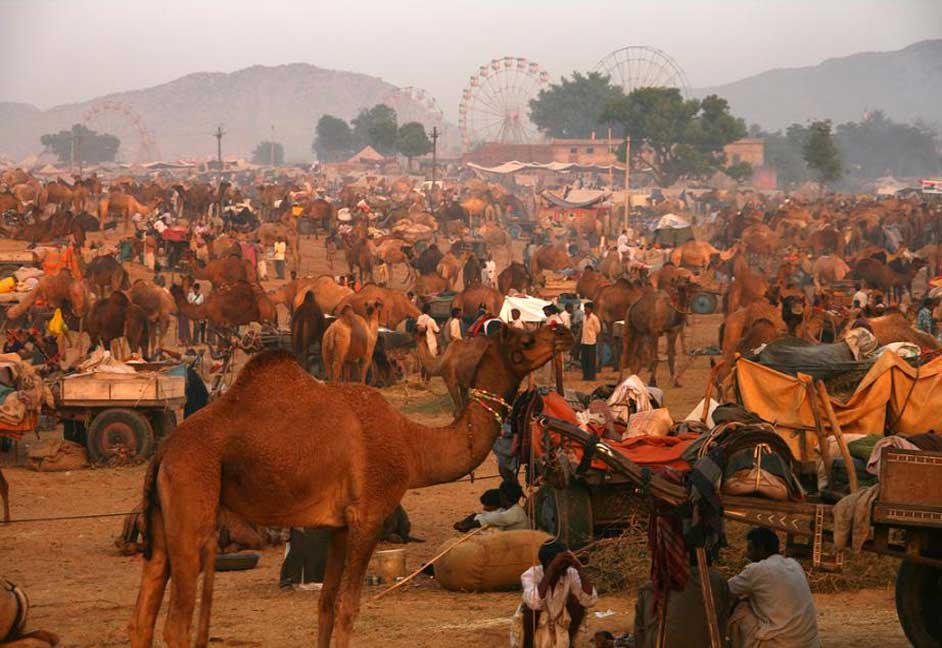 |
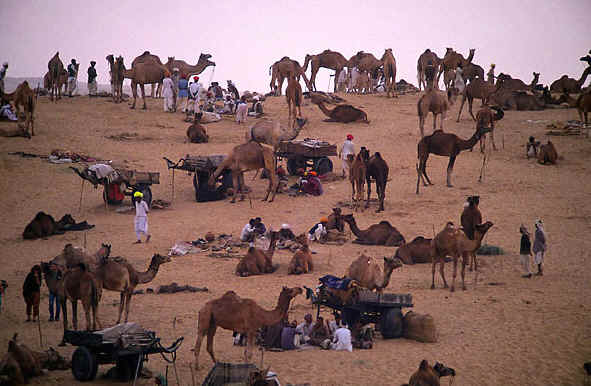 |
|
Pushkar Fair of Pushkar |
Pushkar Fair of Pushkar |
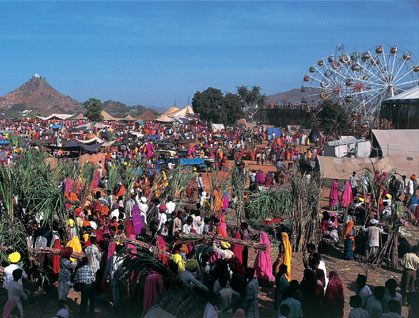 |
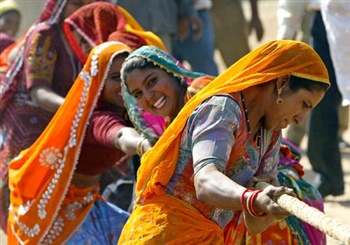 |
|
Pushkar Fair of Pushkar |
Tug of War at Pushkar Fair |
|
|
|
|
|
|
|
|